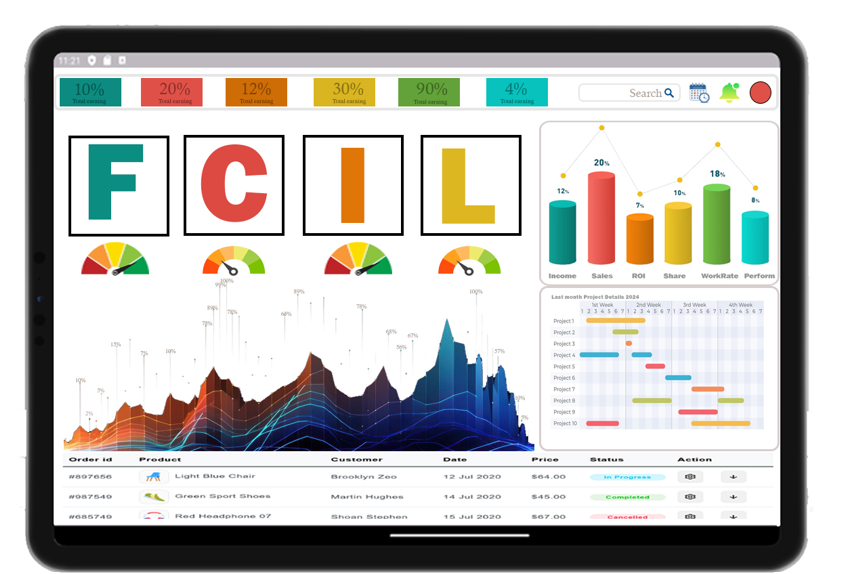In today’s rapidly changing business landscape, organizations need effective tools to measure performance, align strategies, and drive continuous improvement. The Digital Balanced Scorecard(BSC) emerges as a powerful strategic management tool that integrates traditional Balanced Scorecard principles with digital technologies, enabling organisations to achieve a comprehensive view of their performance across various dimensions.

1. Holistic Performance Measurement
One of the primary advantages of Digital Balanced Scorecards is their ability to provide a holistic view of organizational performance. Unlike traditional performance measurement systems that focus solely on financial metrics, DBSCs integrate both financial and non-financial metrics. This allows organizations to assess their performance across four key perspectives:
- Financial: Traditional financial metrics, such as revenue growth, profitability, and return on investment.
- Customer: Metrics related to customer satisfaction, retention, and market share.
- Internal Processes: Measures of operational efficiency, quality, and innovation processes.
- Learning and Growth: Indicators of employee engagement, skills development, and organizational culture.
By capturing a broad spectrum of performance data, organizations can better understand how various factors contribute to overall success.
2. Real-Time Data Access
The digital nature of DBSCs allows organizations to collect and analyze data in real time. This capability is crucial for making timely, informed decisions. Traditional reporting systems often involve delays in data collection and analysis, leading to missed opportunities or delayed responses to challenges.
With Digital Balanced Scorecards(BSC), organizations can access up-to-date performance metrics at any time, enabling leaders to identify trends, track progress, and respond to emerging issues quickly. This agility is essential in today’s fast-paced business environment, where market conditions can change rapidly.
3. Enhanced Strategic Alignment
A Digital Balanced Scorecard(BSC) ensures that all levels of the organization are aligned with strategic objectives. By linking Key Performance Indicators (KPIs) to the organization’s overall strategy, teams can understand how their individual contributions impact broader goals.
For example, if an organisation’s strategic goal is to improve customer satisfaction, departments such as sales, marketing, and customer service can establish relevant KPIs that support this objective. This alignment fosters a culture of collaboration, where all employees work together toward common goals, enhancing overall organizational effectiveness.
4. Improved Decision-Making
Access to accurate, real-time data empowers leaders to make informed decisions based on insights rather than intuition. With DBSCs, organizations can identify performance trends, assess risks, and uncover opportunities for improvement.
For instance, if a manufacturing company notices a decline in production efficiency through its DBSC, it can quickly investigate the root causes and implement corrective actions. This proactive approach to decision-making enables organizations to stay ahead of challenges and seize opportunities for growth.
5. Increased Accountability
Digital Balanced Scorecards(BSC) promote a culture of accountability by clearly defining performance expectations and outcomes. When employees understand how their performance is measured and how it contributes to organizational success, they are more likely to take ownership of their roles.
By assigning specific KPIs to individuals and teams, organizations can foster accountability at all levels. This transparency helps to motivate employees, driving them to achieve their targets and improve overall performance.
6. Focus on Continuous Improvement
DBSCs encourage organizations to adopt a mindset of continuous improvement. Regularly reviewing performance metrics allows organizations to identify areas for enhancement and drive innovation.
For example, an organization may track employee engagement scores through its Digital Balanced Scorecard(BSC) and find that certain departments consistently underperform. By investigating these trends, the organization can implement initiatives to enhance employee satisfaction, leading to higher productivity and better retention rates.
7. Enhanced Communication
Effective communication is essential for organizational success. Digital Balanced Scorecards facilitate better communication by visualizing performance metrics through dashboards and reports. Stakeholders at all levels can easily understand progress, challenges, and areas for improvement.
This improved communication fosters collaboration and engagement across the organization. When employees have access to relevant data and insights, they are more likely to contribute to discussions, share ideas, and work together to solve problems.
8. Adaptability and Agility
The fast-paced nature of modern business requires organizations to be adaptable and agile. DBSCs enable organizations to quickly adjust their metrics and priorities in response to changing market conditions or strategic shifts.
For instance, during a sudden market downturn, an organization can modify its KPIs to focus on cost reduction and operational efficiency. This flexibility ensures that the scorecard remains relevant and aligned with current business needs.
9. Benchmarking and Best Practices
Digital Balanced Scorecards provide organizations with the tools to benchmark their performance against industry standards or competitors. By comparing their metrics with those of industry leaders, organizations can identify best practices and areas for improvement.
This benchmarking process helps organisations understand their competitive position and informs strategic planning efforts. By learning from industry leaders, organizations can adopt successful strategies and enhance their own performance.
10. Support for Strategic Planning
DBSCs play a crucial role in the strategic planning process by providing a structured framework for setting objectives, measuring progress, and evaluating outcomes. This structured approach enhances the effectiveness of strategic initiatives.
During the planning phase, organizations can use DBSCs to define clear objectives and establish relevant KPIs. By regularly reviewing performance against these metrics, organizations can assess the effectiveness of their strategies and make data-driven adjustments as needed.
How Digital Balanced Scorecards Help Organizations
1. What is a Digital Balanced Scorecard?
A Digital Balanced Scorecard is an online version of the traditional Balanced Scorecard. It helps organizations track and manage performance metrics across strategic goals by using real-time data, dashboards, and automated reports.

2. How does a Digital Balanced Scorecard work?
A Digital Balanced Scorecard works by automating the tracking of key performance indicators (KPIs) and displaying progress in real-time. It integrates with other systems, allowing for centralized data collection and analysis.
3. What are the advantages of using a Digital Balanced Scorecard over a traditional one?
The main advantages of using a Digital Balanced Scorecard include real-time data tracking, automated reporting, easier collaboration, remote accessibility, and seamless integration with other business tools like ERP or CRM systems.
4. How does a Digital Balanced Scorecard improve strategic alignment?
A Digital Balanced Scorecard improves strategic alignment by providing real-time visibility into performance metrics across departments, ensuring that all teams are working towards the same organizational goals.
5. Can a Digital Balanced Scorecard be customized for different industries?
Yes, Digital Balanced Scorecards can be customized to meet the specific needs of various industries by adjusting metrics, perspectives, and goals according to the organization’s strategic priorities.
6. How does a Digital Balanced Scorecard enhance data-driven decision-making?
Digital Balanced Scorecards enhance data-driven decision-making by providing real-time data on KPIs, helping managers identify trends and make informed decisions that align with their strategic objectives.
7. What are the main components of a Digital Balanced Scorecard?
The main components include real-time dashboards, KPI tracking, strategy maps, automated reporting, and integrations with other business tools to provide a comprehensive view of organizational performance.
8. How can a Digital Balanced Scorecard facilitate performance monitoring?
A Digital Balanced Scorecard facilitates performance monitoring by allowing managers to track progress in real-time, compare performance against targets, and identify areas for improvement quickly and effectively.
9. How does a Digital Balanced Scorecard promote accountability in an organization?
A Digital Balanced Scorecard promotes accountability by clearly assigning responsibility for specific KPIs and objectives to team members, allowing for transparent tracking and performance evaluation.
10. What are the security features of a Digital Balanced Scorecard?
Security features of a Digital Balanced Scorecard include user authentication, data encryption, access control, and audit logs to ensure that sensitive information is protected from unauthorized access.
11. Can Digital Balanced Scorecards integrate with other business tools?
Yes, Digital Balanced Scorecards can integrate with various business tools such as ERP systems, CRM platforms, and data analytics tools to provide a comprehensive view of organizational performance and streamline workflows.
12. How does a Digital Balanced Scorecard support remote teams?
Digital Balanced Scorecards support remote teams by offering cloud-based access, allowing team members to track, update, and collaborate on performance metrics in real-time from any location.
13. What are the cost benefits of using a Digital Balanced Scorecard?
The cost benefits include reduced manual reporting, improved efficiency in tracking performance metrics, and better resource allocation by enabling organizations to quickly identify underperforming areas and optimize processes.
14. How does a Digital Balanced Scorecard improve communication within an organization?
A Digital Balanced Scorecard improves communication by providing a centralized platform where performance data can be shared and reviewed across departments, fostering better collaboration and transparency.
15. How does a Digital Balanced Scorecard support continuous improvement?
By tracking performance metrics continuously, a Digital Balanced Scorecard helps organizations identify areas for improvement and make data-driven decisions that contribute to ongoing strategic enhancements.